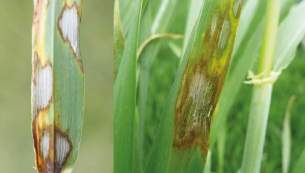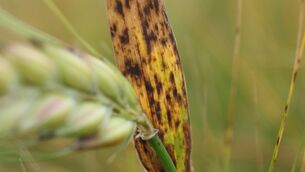Spot Blotch
Cochiobolus sativus
Spot blotch (Cochiobolus sativus) is an uncommon expression of net blotch, a common disease of autumn sown barley (much less commonly spring sown barley). Spot blotch lesions are dark-brown and
elliptical in shape.

Related Pests

Scald
Rhynchosporium secalis
Scald (Rhynchosporium secalis) is a common disease of barley which can result in significant yield loss if not controlled. Scald is favoured by cooler, moist conditions with the initial source of inoculum being infected straw
debris. The first symptoms often appear during winter or early spring, initially as pale greyish lesions which then develop a more straw coloured appearance with a defined dark edge to the lesion.

Net Blotch
Pyreophora teres
Net blotch (Pyreophora teres) is a common disease of autumn sown barley (much less commonly spring sown barley) which can result in significant yield loss if not controlled. Charateristics net type lesions
give the disease its common name but lesions can also take the form of dark stripes and streaks and when infection is severe in large dead areas of leaf. Infection sources are either seed or crop debris, which is borne out by second year barley crops being likely to carry infection. Net blotch development is favoured by cool, moist conditions.

Ramularia Leaf Spot
Ramularia collo-cygni
Ramularia leaf spot (Ramularia collo-cygni) is a common disease of barley which can result in significant yield loss if not controlled. While both winter and spring planted barley can be affected, the impact of Ramularia is
usually greater on winter planted crops. Ramularia is seed borne and once the fungus has infected the plant it grows within the plant, not producing visible symptoms until around ear emergence. Symptoms consist of small brown lesions which under the right conditions can rapidly increase and coalesce together.







